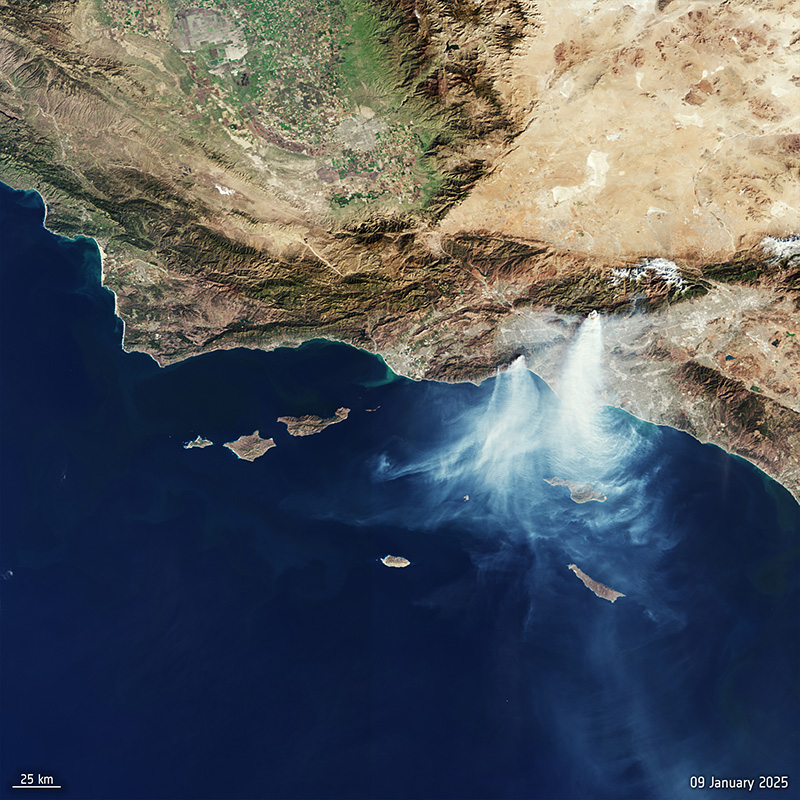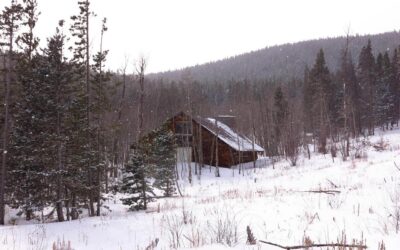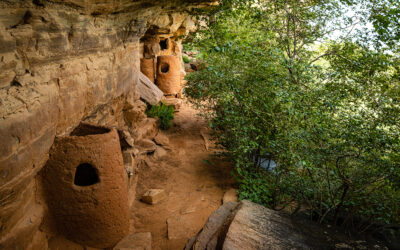A new report examines how atmospheric changes contributed to January’s devastating Southern California wildfires
Reno, Nev. (Feb. 18, 2025) – While fires engulfed large swaths of Southern California in early January, destroying more than 16,000 structures, taking at least 29 lives, and choking the air with smoke, a new study about weather whiplash was released. Co-authored by DRI’s Christine Albano, the research examined how the changing climate is creating an atmosphere more prone to extreme weather. Now, Albano and her co-authors have released a new report that applies the knowledge gained from January’s study to the recent fires, analyzing the broader climatic context that contributed to the unprecedented infernos.
Published February 7th in the “Science Behind the News” section of Global Change Biology, the research details the environmental factors that set the scene for disaster. First, two consecutive wet winters filled with atmospheric river storms led to explosive plant growth across the region. Then, unusually warm temperatures created a thirstier atmosphere that drew moisture from the plants, making them prone to catch fire with the smallest spark. A delayed onset of the wet season led to one of the driest early winters on record, which overlapped with seasonal Santa Ana winds. Wind gusts of more than 80 mph dried the plant life even further, priming the fuels that fed the rapid spread of flames.
“We really wanted to help people understand this link between changes in the atmosphere and increasing risks for the kind of devastating wildfires we saw in Southern California,” said Christine Albano, ecohydrologist at DRI and co-author of the report. “Extreme winters and extreme droughts are two sides of the same atmospheric coin, and a flip of that coin can prime the landscape for dangerous burns.”
The report authors refer to this environmental pendulum that swings rapidly from intense downpours and flooding risk to drought conditions and wildfires as “hydroclimate whiplash.” In places like Southern California, where the ecosystem is prone to wildfires, this extreme weather variability is fueling the conditions that lead to more intense burns. This is especially true when the rainy season is delayed until after the Santa Ana winds, with their inherent ability to fan flames and launch sparks miles from the source.

This weather whiplash phenomenon isn’t restricted to California, however — it is increasing globally. The cause is an atmosphere increasingly acting like an enormous sponge, with the ability to both draw more moisture from soils and plant life and to subsequently release it in deluges. The researchers calculated that at a planetary warming rate of 3°C above pre-industrial levels, these weather whiplash events will double worldwide.
Managing this increased wildfire risk will require addressing a range of factors, from where we build our homes and increased attention to their design, to addressing the spread of fire-fueling invasive plants.
“The interventions with the greatest potential to reduce risk of fire disasters in the short term can be implemented at the local scale: increasing fire resistance of structures, managing vegetation in/near communities, and preventing unwanted high-risk ignitions,” said Daniel Swain, climate scientist at UCLA who led the research.
DRI researchers, including report co-author Albano, are leading the way in helping communities adapt to these weather extremes. Together with DRI’s Maureen McCarthy, Albano is working with emergency managers and stakeholders across the Tahoe and Truckee Meadows communities to integrate extreme weather simulations into emergency planning and exercises.
“This research can help increase awareness of the growing dual risks of extreme drought and wildfire risk and intense precipitation,” Albano said. “The two are intrinsically linked, and we need to consider how each event can fuel another in order to best prepare communities to manage these risks.”
More information: The full study, Increasing Hydroclimatic Whiplash Can Amplify Wildfire Risk in a Warming Climate, is available from Global Change Biology at https://onlinelibrary.wiley.com/doi/full/10.1111/gcb.70075
Study authors include: Daniel L. Swain (UCLA), John T. Abatzoglou (UC Merced), Christine M. Albano (DRI), Manuela I. Brunner (ETH Zurich), Noah S. Diffenbaugh (Stanford), Crystal Kolden (UC Merced) (ETH Zurich), Andreas F. Prein (ETH Zurich), Deepti Singh (Washington State U.), Christopher B. Skinner (U. of Massachusetts), Thomas W. Swetnam (U of Arizona), Danielle Touma (U. of Texas, Austin)
About DRI
We are Nevada’s non-profit research institute, founded in 1959 to empower experts to focus on science that matters. We work with communities across the state — and the world — to address their most pressing scientific questions. We’re proud that our scientists continuously produce solutions that better human and environmental health.
Scientists at DRI are encouraged to follow their research interests across the traditional boundaries of scientific fields, collaborating across DRI and with scientists worldwide. All faculty support their own research through grants, bringing in nearly $5 to the Nevada economy for every $1 of state funds received. With more than 600 scientists, engineers, students, and staff across our Reno and Las Vegas campuses, we conducted more than $52 million in sponsored research focused on improving peoples’ lives in 2024 alone.
At DRI, science isn’t merely academic — it’s the key to future-proofing our communities and building a better world. For more information, please visit www.dri.edu.
Media Contact
Elyse DeFranco
Lead Science Writer & Public Information Officer
elyse.defranco@dri.edu


